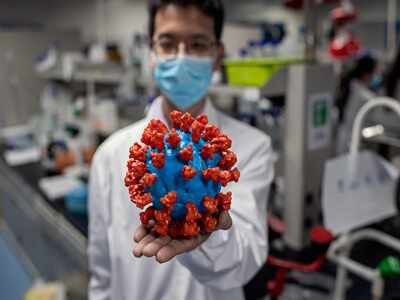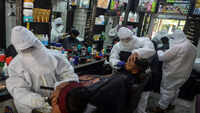
A virus, at heart, is information, a packet of data that benefits from being shared.
The information at stake is genetic: instructions to make more virus. Unlike a truly living organism, a virus cannot replicate on its own; it cannot move, grow, persist or perpetuate. It needs a host. The viral code breaks into a living cell, hijacks the genetic machinery and instructs it to produce new code — new virus.
President Donald Trump has characterized the response to the pandemic as a “medical war,” and described the virus behind it as, by turns, “genius,” a “hidden enemy” and “a monster.” It would be more accurate to say that we find ourselves at odds with a microscopic photocopy machine. Not even that: an assembly manual for a photocopier, model SARS-CoV-2.
Coronavirus outbreak: Complete coverage
For at least six months now, the virus has replicated among us. The toll has been devastating. Officially, more than 6 million people worldwide have been infected so far, and 370,000 have died. (The actual numbers are certainly higher.)
The United States, which has seen the largest share of cases and casualties, recently surpassed 100,000 deaths, one-quarter the number of all Americans who died in World War II. Businesses are shuttered — in 10 weeks, some 40 million Americans have lost their jobs — and food banks are overrun. The virus has fueled widespread frustration and exposed our deepest faults: of color, class and privilege, between the deliverers and the delivered to.
Coronavirus outbreak live: Follow news and updates
Still, summer — summer! — has all but arrived. We step out to look, breathe, vent. The pause is illusory. Cases are falling in New York, the epicenter in the United States, but firmly rising in Wisconsin, Virginia, Alabama, Arkansas, North and South Carolina, and other states. China, where the pandemic originated, and South Korea saw recent resurgences. Health officials fear another major wave of infections in the fall, and a possible wave train beyond.
“We are really early in this disease,” Dr Ashish Jha, director of the Harvard Global Health Institute, told The New York Times recently. “If this were a baseball game, it would be the second inning.”
There may be trillions of species of virus in the world. They infect bacteria, mostly, but also abalone, bats, beans, beetles, blackberries, cassavas, cats, dogs, hermit crabs, mosquitoes, potatoes, pangolins, ticks and the Tasmanian devil. They give birds cancer and turn bananas black. Of the trillions, a few hundred thousand kinds of viruses are known, and fewer than 7,000 have names. Only about 250, including SARS-CoV-2, have the mechanics to infect us.
More on Covid-19
Coronavirus: What are the symptoms52 testing sites for coronavirus in IndiaHelpline numbers for states and UTsDo fever and cough mean you need Covid-19 test?How to stay safeHow to quarantine yourself at home
In our information age, we have grown familiar with computer viruses and with memes going viral; now here is the real thing to remind us what the metaphor means. A mere wisp of data has grounded more than half of the world’s commercial airplanes, sharply reduced global carbon emissions and doubled the stock price of Zoom. It has infiltrated our language — “social distancing,” “immunocompromised shoppers” — and our dreams. It has postponed sports, political conventions, and the premieres of the next Spider-Man, Black Widow, Wonder Woman and James Bond films. Because of the virus, the US Supreme Court renders rulings by telephone, and wild boars roam the empty streets of Barcelona, Spain.
It also has prompted a collaborative response unlike any our species has seen. Teams of scientists, working across national boundaries, are racing to understand the virus’s weaknesses, develop treatments and vaccine candidates, and to accurately forecast its next moves. Medical workers are risking their lives to tend to the sick. Those of us at home do what we can: share instructions for how to make a surgical mask from a pillowcase; sing and cheer from windows and doorsteps; send condolences; offer hope.
“We’re mounting a reaction against the virus that is truly unprecedented,” said Dr. Melanie Ott, director of the Gladstone Institute of Virology in San Francisco.
So far the match is deadlocked. We gather, analyze, disseminate, probe: What is this thing? What must be done? When can life return to normal? And we hide while the latest iteration of an ancient biochemical cipher ticks on, advancing itself at our expense.
A Fearsome Envelope
Who knows when viruses first came about. Perhaps, as one theory holds, they began as free-living microbes that, through natural selection, were stripped down and became parasites. Maybe they began as genetic cogs within microbes, then gained the ability to venture out and invade other cells. Or maybe viruses came first, shuttling and replicating in the primordial protein soup, gaining shades of complexity — enzymes, outer membranes — that gave rise to cells and, eventually, us. They are sacks of code — double- or single-stranded, DNA or RNA — and sometimes called capsid-encoding organisms, or CEOs.
As viruses go, SARS-CoV-2 is big — its genome is more than twice the size of that of the average flu virus and about one-half larger than Ebola’s. But it is still tiny: 10,000 times smaller than a millimeter, barely one-thousandth the width of a human hair, smaller even than the wavelength of light from a germicidal lamp. If a person were the size of Earth, the virus would be the size of a person. Picture a human lung cell as a cramped office just big enough for a desk, a chair and a copy machine. SARS-CoV-2 is an oily envelope stuck to the door.
It was formally identified on Jan. 7 by scientists in China. For weeks beforehand, a mysterious respiratory ailment had been circulating in the city of Wuhan. Health officials were worried that it might be a reappearance of severe acute respiratory syndrome, or SARS, an alarming viral illness that emerged abruptly in 2002, infected more than 8,000 people and killed nearly 800 in the next several months, then was quarantined into oblivion.
The scientists had gathered fluid samples from three patients and, with nucleic-acid extractors and other tools, compared the genome of the pathogen with that of known ones. A transmission electron microscope revealed the culprit: spherical, with “quite distinctive spikes” reminiscent of a crown or the corona of the sun. It was a coronavirus, and a novel one.
In later colorized images, the virus resembles small garish orbs of lint or the papery eggs of certain spiders, adhering by the dozens to much larger cells. Recently a visual team, working closely with researchers, created “the most accurate model of the SARS-CoV-2 viral particle currently available”: a barbed, multicolored globe with the texture of fine moss, like something out of Dr. Seuss, or a sunken naval mine draped in algae and sponges.
Once upon a time, our pathogens were crudely named: Spanish flu, Asian flu, yellow fever, Black Death. Now we have H1N1, MERS (Middle East respiratory syndrome), HIV — strings of letters as streamlined as the viruses themselves, codes for codes. The new coronavirus was temporarily named 2019-nCoV. On Feb. 11, the International Committee on Taxonomy of Viruses officially renamed it SARS-CoV-2, to indicate that it was very closely related to the SARS virus, another coronavirus.
Before the emergence of the original SARS, the study of coronaviruses was a professional backwater. “There has been such a deluge of attention on we coronavirologists,” said Susan R. Weiss, a virologist at the University of Pennsylvania. “It is quite in contrast to previously being mostly ignored.”
There are hundreds of kinds of coronaviruses. Two, SARS-CoV and MERS-CoV, can be deadly; four cause one-third of common colds. Many infect animals with which humans associate, including camels, cats, chickens and bats. All are RNA viruses. Our coronavirus, like the others, is a string of roughly 30,000 biochemical building blocks called nucleotides enclosed in a membrane of both protein and lipid.
“I’ve always been impressed by coronaviruses,” said Anthony Fehr, a virologist at the University of Kansas. “They are extremely complex in the way that they get around and start to take over a cell. They make more genes and more proteins than most other RNA viruses, which gives them more options to shut down the host cell.”
The core code of SARS-CoV-2 contains genes for as many as 29 proteins: the instructions to replicate the code. One protein, S, provides the spikes on the surface of the virus and unlocks the door to the target cell. The others, on entry, separate and attend to their tasks: turning off the cell’s alarm system; commandeering the copier to make new viral proteins; folding viral envelopes, and helping new viruses bubble out of the cell by the thousands.
“I usually picture it as an entity that comes into the cell and then it falls apart,” Ott of the Gladstone Institute said. “It has to fall apart to build some mini-factories in the cell to reproduce itself, and has to come together as an entity at the end to infect other cells.”
For medical researchers, these proteins are key to understanding why the virus is so successful, and how it might be neutralized. For instance, to break into a cell, the S protein binds to a receptor called angiotensin converting enzyme 2, or ACE2, like a hand on a doorknob. The S protein on this coronavirus is nearly identical in structure to the one in the first SARS — “SARS Classic” — but some data suggests that it binds to the target enzyme far more strongly. Some researchers think this may partly explain why the new virus infects humans so efficiently.
Every pathogen evolves along a path between impact and stealth. Too mild and the illness does not spread from person to person; too visible and the carrier, unwell and aware, stays home or is avoided — and the illness does not spread. “SARS infected 8,000 people, and was contained quickly, in part because it didn’t spread before symptoms appeared,” Weiss noted.
By comparison, SARS-CoV-2 seems to have achieved an admirable balance. “No aspect of the virus is extraordinary,” said Dr. Pardis Sabeti, a computational geneticist at the Broad Institute who helped sequence the Ebola virus in 2014. “It’s the combination of things that makes it extraordinary.”
SARS Classic settled quickly into human lung cells, causing a person to cough but also announcing its presence. In contrast, its successor tends to colonize first the nose and throat, sometimes causing few initial symptoms. Some cells there are thought to be rich in the surface enzyme ACE2 — the doorknob that SARS-CoV-2 turns so readily. The virus replicates quietly, and quietly spreads: One study found that a person carrying SARS-CoV-2 is most contagious two to three days before they are aware that they might be ill.
From there, the virus can move into the lungs. The delicate alveoli, which gather oxygen essential to the body, become inflamed and struggle to do their job. The texture of the lungs turns from airy froth to gummy marshmallow. The patient may develop pneumonia; some, drowning internally and desperate for oxygen, go into acute respiratory distress and require a ventilator.
The virus can settle in still further: damaging the muscular walls of the heart; attacking the lining of the blood vessels and generating clots; inducing strokes, seizures and inflammation of the brain; and damaging the kidneys. Often the greatest damage is inflicted not by the virus but by the body’s attempt to fight it off with a dangerous “cytokine storm” of immune system molecules.
The result is an illness with a perplexing array of faces. A dry cough and a low fever at the outset, sometimes. Shortness of breath or difficulty breathing, sometimes. Maybe you lose your sense of smell or taste. Maybe your toes become red and inflamed, as if you had frostbite. For some patients it feels like a heart attack, or it causes delusion or disorientation.
Often it feels like nothing at all; according to the Centers for Disease Control and Prevention, 35% of people who contract the virus experience few to no symptoms, although they can continue to spread it. “The virus acts like no pathogen humanity has ever seen,” the journal Science notes.
More to the point, the pathogen has gone largely unseen. “It has these perfect properties to spread throughout the entire human population,” Fehr said. “If we didn’t know what a virus was” — and didn’t take proper precautions — “this virus would infect virtually every human on the planet. It still might do that.”
Data vs Data
On Jan 10, the Wuhan health commission in China reported that in the previous weeks, 41 people had contracted the illness caused by the coronavirus, and that one had died — the first known casualty at the time.
That same day, Chinese scientists publicly released the complete genome of the virus. The blueprint, which could be simulated and synthesized in the lab, was almost as good as a physical sample, and easier for researchers worldwide to obtain. Analyses appeared in journals and on preprint servers like bioRxiv, on sites like nextstrain.org and virological.org: clues to the virus’s origin, its errors and its weaknesses. From then on, the new coronavirus began to replicate not only physically in human cells but also figuratively, and likely to its own detriment, in the human mind.
Ott entered medicine in the 1980s, when AIDS was still new and terrifyingly unknown. “Compare that time to today, there are a lot of similarities,” she said. “A new virus, a rush to understand, a rush to a cure or a vaccine. What’s fundamentally different now is that we have generated this community of collaboration and data-sharing. It’s really mind-blowing.”
Three hours after the virus’s code was published, Inovio Pharmaceuticals, based in San Diego, began work on a vaccine against it — one of more than 100 such efforts now underway around the world. Sabeti’s lab quickly got to work developing diagnostic tests. Ott and Weiss soon managed to obtain samples of live virus, which allowed them to “actually look at what’s going on” when it infects cells in the lab, Ott said.
“The cell is mounting a profound battle to prevent the virus from entering or, on entering, to alarm everyone around it so it can’t spread,” she said. “The virus’s intent is to overcome this initial surge of defense, to set up shop long enough to reproduce itself and to spread.”
With so many proteins in its tool kit, the virus has many ways to counter our immune system; these also offer targets for potential vaccines and drugs. Researchers are working every angle. Most vaccine efforts are focused on disrupting the spike proteins, which allow entry into the cell. The drug remdesivir targets the virus’s replication machinery. Fehr studies how the virus disables our immune system.
“I use the analogy of ‘Star Wars,’” he said. “The virus is the Dark Side. We have a cellular defense system of hundreds of antiviral proteins” — Jedi knights — “to defend ourselves. Our lab is studying one specific Jedi that uses one particular weapon, and how the virus fights back.”
These battles, fought on the field of biochemistry, strain the alphabet to describe. The Jedi in this analogy are particular enzymes (poly-ADP-ribose polymerases, or PARPS, if you must know) that are produced in infected cells and wield a molecule that attaches to certain invading proteins — “We don’t know what these are yet,” Fehr said — and disrupts them. In response, the virus has an enzyme of its own that sweeps away our Jedi like dust from a sandcrawler.
Carolyn Machamer, a cell biologist at the Johns Hopkins School of Medicine, is studying the later stages of the process, to learn how the virus manages to navigate and assemble itself within a host cell and depart it. Among the research topics listed on her university webpage are coronaviruses but also “intracellular protein trafficking” and “exocytosis of large cargo.”
On entering the cell, components of the virus set up shop in a subregion, or organelle, called the Golgi complex, which resembles a stack of pancakes and serves as the cell’s mail-sorting center. Machamer has been working to understand how the virus commandeers the unit to route all the newly replicated viral bits, scattered throughout the cell, for final assembly.
The subject was “poorly studied,” she conceded. Most drug research has focused on the early stages, like blocking infection at the very outset or disrupting replication inside the cell. “Like I said, it hasn’t gotten a whole lot of attention,” she said. “But I think it will now, because I think we have some really interesting targets that could possibly yield new types of drugs.”
The line of inquiry dates back to her postdoctoral days. She was studying the Golgi complex — “The organelle is really bizarre” — even then. “It’s following what you’re interested in; that’s what basic science is about. It’s, like, you don’t actually set out to cure the world or anything, but you follow your nose.”
For all the attention the virus has received, it is still new to science and rich in unknowns. “I’m still very focused on the question: How does the virus get into the body?” Ott said. “Which cells does it infect in the upper airway? How does it get into the lower airway, and from there to other organs? It’s absolutely not clear what the path is, or what the vulnerable path types are.”
And most pressing: Why are so many of us asymptomatic? “How does the virus manage to do this without leaving traces in some people, but in others there’s a giant reaction?” she said. “That’s the biggest question currently, and the most urgent.”
The information at stake is genetic: instructions to make more virus. Unlike a truly living organism, a virus cannot replicate on its own; it cannot move, grow, persist or perpetuate. It needs a host. The viral code breaks into a living cell, hijacks the genetic machinery and instructs it to produce new code — new virus.
President Donald Trump has characterized the response to the pandemic as a “medical war,” and described the virus behind it as, by turns, “genius,” a “hidden enemy” and “a monster.” It would be more accurate to say that we find ourselves at odds with a microscopic photocopy machine. Not even that: an assembly manual for a photocopier, model SARS-CoV-2.
Coronavirus outbreak: Complete coverage
For at least six months now, the virus has replicated among us. The toll has been devastating. Officially, more than 6 million people worldwide have been infected so far, and 370,000 have died. (The actual numbers are certainly higher.)
The United States, which has seen the largest share of cases and casualties, recently surpassed 100,000 deaths, one-quarter the number of all Americans who died in World War II. Businesses are shuttered — in 10 weeks, some 40 million Americans have lost their jobs — and food banks are overrun. The virus has fueled widespread frustration and exposed our deepest faults: of color, class and privilege, between the deliverers and the delivered to.
Coronavirus outbreak live: Follow news and updates
Still, summer — summer! — has all but arrived. We step out to look, breathe, vent. The pause is illusory. Cases are falling in New York, the epicenter in the United States, but firmly rising in Wisconsin, Virginia, Alabama, Arkansas, North and South Carolina, and other states. China, where the pandemic originated, and South Korea saw recent resurgences. Health officials fear another major wave of infections in the fall, and a possible wave train beyond.
“We are really early in this disease,” Dr Ashish Jha, director of the Harvard Global Health Institute, told The New York Times recently. “If this were a baseball game, it would be the second inning.”
There may be trillions of species of virus in the world. They infect bacteria, mostly, but also abalone, bats, beans, beetles, blackberries, cassavas, cats, dogs, hermit crabs, mosquitoes, potatoes, pangolins, ticks and the Tasmanian devil. They give birds cancer and turn bananas black. Of the trillions, a few hundred thousand kinds of viruses are known, and fewer than 7,000 have names. Only about 250, including SARS-CoV-2, have the mechanics to infect us.
More on Covid-19
Coronavirus: What are the symptoms52 testing sites for coronavirus in IndiaHelpline numbers for states and UTsDo fever and cough mean you need Covid-19 test?How to stay safeHow to quarantine yourself at home
In our information age, we have grown familiar with computer viruses and with memes going viral; now here is the real thing to remind us what the metaphor means. A mere wisp of data has grounded more than half of the world’s commercial airplanes, sharply reduced global carbon emissions and doubled the stock price of Zoom. It has infiltrated our language — “social distancing,” “immunocompromised shoppers” — and our dreams. It has postponed sports, political conventions, and the premieres of the next Spider-Man, Black Widow, Wonder Woman and James Bond films. Because of the virus, the US Supreme Court renders rulings by telephone, and wild boars roam the empty streets of Barcelona, Spain.
It also has prompted a collaborative response unlike any our species has seen. Teams of scientists, working across national boundaries, are racing to understand the virus’s weaknesses, develop treatments and vaccine candidates, and to accurately forecast its next moves. Medical workers are risking their lives to tend to the sick. Those of us at home do what we can: share instructions for how to make a surgical mask from a pillowcase; sing and cheer from windows and doorsteps; send condolences; offer hope.
“We’re mounting a reaction against the virus that is truly unprecedented,” said Dr. Melanie Ott, director of the Gladstone Institute of Virology in San Francisco.
So far the match is deadlocked. We gather, analyze, disseminate, probe: What is this thing? What must be done? When can life return to normal? And we hide while the latest iteration of an ancient biochemical cipher ticks on, advancing itself at our expense.
A Fearsome Envelope
Who knows when viruses first came about. Perhaps, as one theory holds, they began as free-living microbes that, through natural selection, were stripped down and became parasites. Maybe they began as genetic cogs within microbes, then gained the ability to venture out and invade other cells. Or maybe viruses came first, shuttling and replicating in the primordial protein soup, gaining shades of complexity — enzymes, outer membranes — that gave rise to cells and, eventually, us. They are sacks of code — double- or single-stranded, DNA or RNA — and sometimes called capsid-encoding organisms, or CEOs.
As viruses go, SARS-CoV-2 is big — its genome is more than twice the size of that of the average flu virus and about one-half larger than Ebola’s. But it is still tiny: 10,000 times smaller than a millimeter, barely one-thousandth the width of a human hair, smaller even than the wavelength of light from a germicidal lamp. If a person were the size of Earth, the virus would be the size of a person. Picture a human lung cell as a cramped office just big enough for a desk, a chair and a copy machine. SARS-CoV-2 is an oily envelope stuck to the door.
It was formally identified on Jan. 7 by scientists in China. For weeks beforehand, a mysterious respiratory ailment had been circulating in the city of Wuhan. Health officials were worried that it might be a reappearance of severe acute respiratory syndrome, or SARS, an alarming viral illness that emerged abruptly in 2002, infected more than 8,000 people and killed nearly 800 in the next several months, then was quarantined into oblivion.
The scientists had gathered fluid samples from three patients and, with nucleic-acid extractors and other tools, compared the genome of the pathogen with that of known ones. A transmission electron microscope revealed the culprit: spherical, with “quite distinctive spikes” reminiscent of a crown or the corona of the sun. It was a coronavirus, and a novel one.
In later colorized images, the virus resembles small garish orbs of lint or the papery eggs of certain spiders, adhering by the dozens to much larger cells. Recently a visual team, working closely with researchers, created “the most accurate model of the SARS-CoV-2 viral particle currently available”: a barbed, multicolored globe with the texture of fine moss, like something out of Dr. Seuss, or a sunken naval mine draped in algae and sponges.
Once upon a time, our pathogens were crudely named: Spanish flu, Asian flu, yellow fever, Black Death. Now we have H1N1, MERS (Middle East respiratory syndrome), HIV — strings of letters as streamlined as the viruses themselves, codes for codes. The new coronavirus was temporarily named 2019-nCoV. On Feb. 11, the International Committee on Taxonomy of Viruses officially renamed it SARS-CoV-2, to indicate that it was very closely related to the SARS virus, another coronavirus.
Before the emergence of the original SARS, the study of coronaviruses was a professional backwater. “There has been such a deluge of attention on we coronavirologists,” said Susan R. Weiss, a virologist at the University of Pennsylvania. “It is quite in contrast to previously being mostly ignored.”
There are hundreds of kinds of coronaviruses. Two, SARS-CoV and MERS-CoV, can be deadly; four cause one-third of common colds. Many infect animals with which humans associate, including camels, cats, chickens and bats. All are RNA viruses. Our coronavirus, like the others, is a string of roughly 30,000 biochemical building blocks called nucleotides enclosed in a membrane of both protein and lipid.
“I’ve always been impressed by coronaviruses,” said Anthony Fehr, a virologist at the University of Kansas. “They are extremely complex in the way that they get around and start to take over a cell. They make more genes and more proteins than most other RNA viruses, which gives them more options to shut down the host cell.”
The core code of SARS-CoV-2 contains genes for as many as 29 proteins: the instructions to replicate the code. One protein, S, provides the spikes on the surface of the virus and unlocks the door to the target cell. The others, on entry, separate and attend to their tasks: turning off the cell’s alarm system; commandeering the copier to make new viral proteins; folding viral envelopes, and helping new viruses bubble out of the cell by the thousands.
“I usually picture it as an entity that comes into the cell and then it falls apart,” Ott of the Gladstone Institute said. “It has to fall apart to build some mini-factories in the cell to reproduce itself, and has to come together as an entity at the end to infect other cells.”
For medical researchers, these proteins are key to understanding why the virus is so successful, and how it might be neutralized. For instance, to break into a cell, the S protein binds to a receptor called angiotensin converting enzyme 2, or ACE2, like a hand on a doorknob. The S protein on this coronavirus is nearly identical in structure to the one in the first SARS — “SARS Classic” — but some data suggests that it binds to the target enzyme far more strongly. Some researchers think this may partly explain why the new virus infects humans so efficiently.
Every pathogen evolves along a path between impact and stealth. Too mild and the illness does not spread from person to person; too visible and the carrier, unwell and aware, stays home or is avoided — and the illness does not spread. “SARS infected 8,000 people, and was contained quickly, in part because it didn’t spread before symptoms appeared,” Weiss noted.
By comparison, SARS-CoV-2 seems to have achieved an admirable balance. “No aspect of the virus is extraordinary,” said Dr. Pardis Sabeti, a computational geneticist at the Broad Institute who helped sequence the Ebola virus in 2014. “It’s the combination of things that makes it extraordinary.”
SARS Classic settled quickly into human lung cells, causing a person to cough but also announcing its presence. In contrast, its successor tends to colonize first the nose and throat, sometimes causing few initial symptoms. Some cells there are thought to be rich in the surface enzyme ACE2 — the doorknob that SARS-CoV-2 turns so readily. The virus replicates quietly, and quietly spreads: One study found that a person carrying SARS-CoV-2 is most contagious two to three days before they are aware that they might be ill.
From there, the virus can move into the lungs. The delicate alveoli, which gather oxygen essential to the body, become inflamed and struggle to do their job. The texture of the lungs turns from airy froth to gummy marshmallow. The patient may develop pneumonia; some, drowning internally and desperate for oxygen, go into acute respiratory distress and require a ventilator.
The virus can settle in still further: damaging the muscular walls of the heart; attacking the lining of the blood vessels and generating clots; inducing strokes, seizures and inflammation of the brain; and damaging the kidneys. Often the greatest damage is inflicted not by the virus but by the body’s attempt to fight it off with a dangerous “cytokine storm” of immune system molecules.
The result is an illness with a perplexing array of faces. A dry cough and a low fever at the outset, sometimes. Shortness of breath or difficulty breathing, sometimes. Maybe you lose your sense of smell or taste. Maybe your toes become red and inflamed, as if you had frostbite. For some patients it feels like a heart attack, or it causes delusion or disorientation.
Often it feels like nothing at all; according to the Centers for Disease Control and Prevention, 35% of people who contract the virus experience few to no symptoms, although they can continue to spread it. “The virus acts like no pathogen humanity has ever seen,” the journal Science notes.
More to the point, the pathogen has gone largely unseen. “It has these perfect properties to spread throughout the entire human population,” Fehr said. “If we didn’t know what a virus was” — and didn’t take proper precautions — “this virus would infect virtually every human on the planet. It still might do that.”
Data vs Data
On Jan 10, the Wuhan health commission in China reported that in the previous weeks, 41 people had contracted the illness caused by the coronavirus, and that one had died — the first known casualty at the time.
That same day, Chinese scientists publicly released the complete genome of the virus. The blueprint, which could be simulated and synthesized in the lab, was almost as good as a physical sample, and easier for researchers worldwide to obtain. Analyses appeared in journals and on preprint servers like bioRxiv, on sites like nextstrain.org and virological.org: clues to the virus’s origin, its errors and its weaknesses. From then on, the new coronavirus began to replicate not only physically in human cells but also figuratively, and likely to its own detriment, in the human mind.
Ott entered medicine in the 1980s, when AIDS was still new and terrifyingly unknown. “Compare that time to today, there are a lot of similarities,” she said. “A new virus, a rush to understand, a rush to a cure or a vaccine. What’s fundamentally different now is that we have generated this community of collaboration and data-sharing. It’s really mind-blowing.”
Three hours after the virus’s code was published, Inovio Pharmaceuticals, based in San Diego, began work on a vaccine against it — one of more than 100 such efforts now underway around the world. Sabeti’s lab quickly got to work developing diagnostic tests. Ott and Weiss soon managed to obtain samples of live virus, which allowed them to “actually look at what’s going on” when it infects cells in the lab, Ott said.
“The cell is mounting a profound battle to prevent the virus from entering or, on entering, to alarm everyone around it so it can’t spread,” she said. “The virus’s intent is to overcome this initial surge of defense, to set up shop long enough to reproduce itself and to spread.”
With so many proteins in its tool kit, the virus has many ways to counter our immune system; these also offer targets for potential vaccines and drugs. Researchers are working every angle. Most vaccine efforts are focused on disrupting the spike proteins, which allow entry into the cell. The drug remdesivir targets the virus’s replication machinery. Fehr studies how the virus disables our immune system.
“I use the analogy of ‘Star Wars,’” he said. “The virus is the Dark Side. We have a cellular defense system of hundreds of antiviral proteins” — Jedi knights — “to defend ourselves. Our lab is studying one specific Jedi that uses one particular weapon, and how the virus fights back.”
These battles, fought on the field of biochemistry, strain the alphabet to describe. The Jedi in this analogy are particular enzymes (poly-ADP-ribose polymerases, or PARPS, if you must know) that are produced in infected cells and wield a molecule that attaches to certain invading proteins — “We don’t know what these are yet,” Fehr said — and disrupts them. In response, the virus has an enzyme of its own that sweeps away our Jedi like dust from a sandcrawler.
Carolyn Machamer, a cell biologist at the Johns Hopkins School of Medicine, is studying the later stages of the process, to learn how the virus manages to navigate and assemble itself within a host cell and depart it. Among the research topics listed on her university webpage are coronaviruses but also “intracellular protein trafficking” and “exocytosis of large cargo.”
On entering the cell, components of the virus set up shop in a subregion, or organelle, called the Golgi complex, which resembles a stack of pancakes and serves as the cell’s mail-sorting center. Machamer has been working to understand how the virus commandeers the unit to route all the newly replicated viral bits, scattered throughout the cell, for final assembly.
The subject was “poorly studied,” she conceded. Most drug research has focused on the early stages, like blocking infection at the very outset or disrupting replication inside the cell. “Like I said, it hasn’t gotten a whole lot of attention,” she said. “But I think it will now, because I think we have some really interesting targets that could possibly yield new types of drugs.”
The line of inquiry dates back to her postdoctoral days. She was studying the Golgi complex — “The organelle is really bizarre” — even then. “It’s following what you’re interested in; that’s what basic science is about. It’s, like, you don’t actually set out to cure the world or anything, but you follow your nose.”
For all the attention the virus has received, it is still new to science and rich in unknowns. “I’m still very focused on the question: How does the virus get into the body?” Ott said. “Which cells does it infect in the upper airway? How does it get into the lower airway, and from there to other organs? It’s absolutely not clear what the path is, or what the vulnerable path types are.”
And most pressing: Why are so many of us asymptomatic? “How does the virus manage to do this without leaving traces in some people, but in others there’s a giant reaction?” she said. “That’s the biggest question currently, and the most urgent.”
Download
The Times of India News App for Latest World News

Coronavirus outbreak
Trending Topics
LATEST VIDEOS
More from TOI
Navbharat Times
Featured Today in Travel
Get the app









